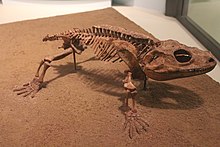| Cacops Temporal range: Early Permian,
| |
|---|---|

| |
| Skeleton of Cacops aspidephorus in the Field Museum | |
| Scientific classification | |
| Domain: | Eukaryota |
| Kingdom: | Animalia |
| Phylum: | Chordata |
| Order: | †Temnospondyli |
| Family: | †Dissorophidae |
| Clade: | †Eucacopinae |
| Genus: | †Cacops Williston, 1910[1] |
| Species | |
Cacops ("ugly look" for its strange appearance), is a genus of dissorophid temnospondyls from the Kungurian stage of the early Permian of the United States.[2][3] Cacops is one of the few olsoniforms (dissorophids and the larger trematopids) whose ontogeny is known.[4][5] Cacops fossils were almost exclusively known from the Cacops Bone Bed of the Lower Permian Arroyo Formation of Texas for much of the 20th century.[1] New material collected from the Dolese Brothers Quarry, near Richards Spur, Oklahoma in the past few decades has been recovered, painting a clearer picture of what the animal looked and acted like.[2][3][6]
- ^ a b Cite error: The named reference
Williston, S. W. (1910)was invoked but never defined (see the help page). - ^ a b Fröbisch, Nadia B.; Reisz, Robert R. (2012). "A new species of dissorophid (Cacops woehri) from the Lower Permian Dolese Quarry, near Richards Spur, Oklahoma". Journal of Vertebrate Paleontology. 32 (1): 35–44. doi:10.1080/02724634.2012.633586. S2CID 131513990.
- ^ a b Reisz, Robert R.; Schoch, Rainer R.; Anderson, Jason S. (2009). "The armoured dissorophid Cacops from the Early Permian of Oklahoma and the exploitation of the terrestrial realm by amphibians". Naturwissenschaften. 96 (7): 789–796. Bibcode:2009NW.....96..789R. doi:10.1007/s00114-009-0533-x. PMID 19347261. S2CID 11397128.
- ^ Cite error: The named reference
Fröbisch, N. B., Brar, A., & Reisz, R. R. (2015)was invoked but never defined (see the help page). - ^ Gee, Bryan M.; Reisz, Robert R. (2018). "Cranial and postcranial anatomy of Cacops morrisi, a eucacopine dissorophid from the early Permian of Oklahoma". Journal of Vertebrate Paleontology. 38 (2): e1433186. doi:10.1080/02724634.2018.1433186. ISSN 0272-4634. S2CID 90120528.
- ^ Bolt, John R. (1977). "Cacops (Amphibia, Labyrinthodontia) from the Fort Sill Locality, Lower Permian of Oklahoma". Fieldiana: Geology. 37: 61–73.